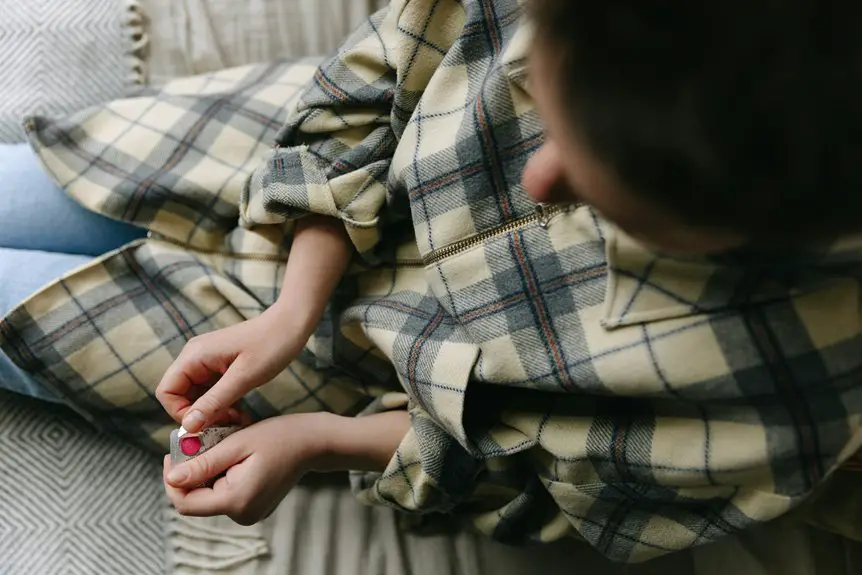To revive old, pilled clothes and make them look new again, start by gently removing the pills using tools like a fabric shaver, lint roller, or sweater comb. Washing carefully in cold water on a gentle cycle and air-drying can prevent further pilling. Opt for tightly woven fabrics and store your garments properly to maintain their appearance. For a deeper understanding of techniques and maintenance practices, there’s more useful information to explore.
Table of Contents
Key Takeaways
- Use a fabric shaver or sweater comb to gently remove pills and restore the garment’s surface.
- Wash clothes in cold water on a gentle cycle to minimize further pilling while cleaning.
- Store garments properly by folding and using breathable bags to prevent future damage.
- Rotate your wardrobe regularly to reduce wear and tear on any single item.
- Consider professional cleaning or tailoring for delicate fabrics and significant damage.
Understanding Pilling: Causes and Effects
Pilling is a common issue that can turn your favorite sweater into a fuzzy eyesore. It happens when fibers in the fabric loosen and tangle together, forming small balls or “pills.” This usually occurs due to friction, whether from regular wear or washing.
Natural fibers, like wool and cashmere, are especially prone to pilling because they’re softer and more delicate. Even synthetic fabrics aren’t immune, as lower-quality materials can develop pills over time.
The result? Your once-pristine clothes look worn and less appealing. Understanding how pilling occurs helps you take better care of your garments.
Essential Tools for Removing Pilling
To keep your clothes looking their best after pilling occurs, having the right tools on hand is key. You’ll want to invest in a few essentials that make the process easier and more effective.
| Tool | Purpose |
|---|---|
| Fabric Shaver | Quickly removes pills from fabric |
| Lint Roller | Picks up loose fibers and pills |
| Sweater Stone | Gently buffs away pilling |
With these tools, you’ll tackle pilling like a pro. A fabric shaver can save you time, while a lint roller helps maintain a polished look. Don’t forget the sweater stone for delicate fabrics. Equip yourself, and your clothes will look fresh and revitalized in no time!
Effective Techniques for Depilling Fabrics
While dealing with pilled fabrics can be frustrating, using the right techniques can make the process much easier.
Here are some effective methods to revive your clothes:
- Lint Roller: Quickly remove loose pills with a lint roller, making it perfect for a fast fix.
- Pumice Stone: Gently rub a pumice stone over the fabric to lift pills while being careful not to damage the fibers.
- Sweater Comb: Use a sweater comb for a more thorough depilling experience, effectively catching and removing pills without harming the fabric.
Step-by-Step Guide to Using Fabric Shavers
Using a fabric shaver can transform your favorite garments, making them look fresh and new again.
Start by laying your clothing on a flat, clean surface. Turn on the fabric shaver and gently glide it over the pilled areas, applying light pressure. Move in one direction to avoid damaging the fabric.
After a few passes, inspect the area to confirm you’re removing the pills without harming the material. Once you’ve finished, clean the shaver’s collection compartment to remove any debris.
If necessary, repeat the process on other sections of the garment. Finally, give your clothing a good shake to remove any residual fibers.
Your revived garment is now ready to wear and enjoy!
Preventing Pilling: Best Practices for Care
To keep your clothes looking fresh and new, it’s essential to adopt some smart care practices.
You can start by washing gently, sorting fabrics properly, and choosing high-quality materials.
These steps will considerably reduce pilling and extend the life of your favorite garments.
Gentle Washing Techniques
When you want to keep your favorite clothes looking fresh and free from pilling, gentle washing techniques play an essential role.
By using the right methods, you can extend the life of your garments and maintain their appearance. Here are some best practices to take into account:
- Use cold water: Washing in cold water reduces friction and helps prevent fibers from breaking down.
- Choose a gentle cycle: Opt for a delicate cycle on your washing machine to minimize agitation, which can lead to pilling.
- Skip the dryer: Air-drying your clothes instead of using a dryer helps preserve their shape and texture.
Implement these techniques, and you’ll notice a significant difference in how your clothes look and feel over time.
Proper Fabric Sorting
Proper fabric sorting can profoundly impact the longevity of your clothes and their resistance to pilling. Start by separating your laundry into categories based on fabric type.
Wash delicate fabrics, like silk and lace, separately from heavier materials, such as denim and towels. This prevents rougher fabrics from causing friction and potential pilling.
Additionally, group similar colors together to avoid color bleeding, which can lead to further damage. Always check care labels for specific washing instructions, and consider using mesh bags for particularly fragile items.
Quality Material Selection
Choosing quality materials is essential for preventing pilling and ensuring your clothes stand the test of time.
When shopping, pay attention to the fabric types you choose, as some are more prone to pilling than others. Here are a few tips to help you select better materials:
- Natural fibers: Look for cotton, linen, or wool, as they tend to resist pilling better than synthetic fabrics.
- Tightly woven fabrics: Opt for materials with a tighter weave, which can reduce friction and minimize pilling.
- Blend wisely: If you choose blends, select those with a higher percentage of natural fibers for durability and comfort.
Tips for Specific Fabric Types
When it comes to reviving your old pilled clothes, different fabric types require unique approaches.
For wool and knits, gentle care is key to maintaining their texture, while delicate fabrics need a more cautious touch to avoid further damage.
Let’s explore tips tailored to these specific materials to help you restore your favorites.
Wool and Knits Care
To keep your wool and knits looking their best, it’s essential to understand their unique care requirements. These fabrics can be delicate, so a little extra attention goes a long way.
Here are some key tips to maintain their quality:
- Wash Carefully: Always hand wash or use a gentle cycle with cold water and a mild detergent specifically designed for wool.
- Avoid Heat: Never wring or twist your wool garments. Instead, lay them flat to dry to prevent stretching and misshaping.
- Store Properly: When storing, fold your knits instead of hanging them, and keep them in a breathable bag to avoid moth damage.
Delicate Fabrics Handling
Caring for wool and knits sets the stage for managing other delicate fabrics.
When it comes to silk, always hand wash in cold water with a gentle detergent. Avoid wringing; instead, lay it flat to dry.
For lace, use a mesh bag while washing to prevent snagging. If you’re dealing with chiffon, steam it carefully rather than ironing to avoid damage.
When handling delicate synthetics like polyester, wash in cold water on a gentle cycle, and never tumble dry—hang to air dry instead.
For cotton blends, you can use a mild detergent and machine wash on a delicate cycle, but be cautious with heat.
Long-Term Maintenance for Revived Clothes
Although you’ve successfully revived your old pilled clothes, maintaining their new look requires ongoing attention and care.
Reviving old pilled clothes is just the beginning; ongoing care is essential for lasting freshness.
To keep your garments looking fresh, follow these tips:
- Wash carefully: Use cold water and gentle detergent. Hand wash when possible to minimize wear.
- Store properly: Fold your revived clothes neatly to avoid stretching. Use breathable garment bags for delicate items.
- Rotate wear: Give your clothes a break. Rotating your wardrobe helps prevent excessive wear on any single piece.
When to Seek Professional Help
Sometimes, despite your best efforts, your revived clothes may still show signs of wear or damage that require professional intervention.
If you notice persistent pilling, fraying seams, or stubborn stains that won’t budge, it might be time to consult a tailor or dry cleaner. Professionals can restore your garments’ integrity, using specialized techniques that you may not have access to at home.
Additionally, if you’re dealing with delicate fabrics or intricate designs, seeking expert help is essential to avoid further damage.
Frequently Asked Questions
Can Pilling Be Completely Eliminated From Fabrics?
Pilling can’t be completely eliminated from fabrics, but you can minimize it by choosing high-quality materials, washing items gently, and using fabric shavers. Regular maintenance keeps your clothes looking better for longer.
How Often Should I Depill My Clothes?
You might wonder how often to tackle those pesky pills. It really depends on wear and tear, but generally, you should depill your clothes every few months, keeping them looking fresh and fabulous for longer.
Is It Safe to Use a Fabric Shaver on All Materials?
You can’t use a fabric shaver on all materials safely. It works well on knits and wool, but delicate fabrics like silk or lace can get damaged. Always test a small area first before proceeding.
What Should I Do if My Fabric Shaver Is Not Working?
When your fabric shaver’s lost its spark, don’t fret. Check the batteries or power source first. If it’s clogged, clean the blades. Sometimes, a little TLC can breathe life back into your trusty tool.
Can Pilling Indicate a Need for Fabric Replacement?
Yes, pilling can indicate that your fabric is wearing out. If you notice excessive pilling, it might be time to contemplate replacing the garment to maintain your wardrobe’s overall appearance and quality.
- What Fabric Is Chino? Unveiling Chino Material - June 20, 2025
- What Fabric Are Chinos Made From? Exploring Chino Fabric - June 20, 2025
- Chino: Fabric or Style? Understanding the Difference - June 20, 2025







